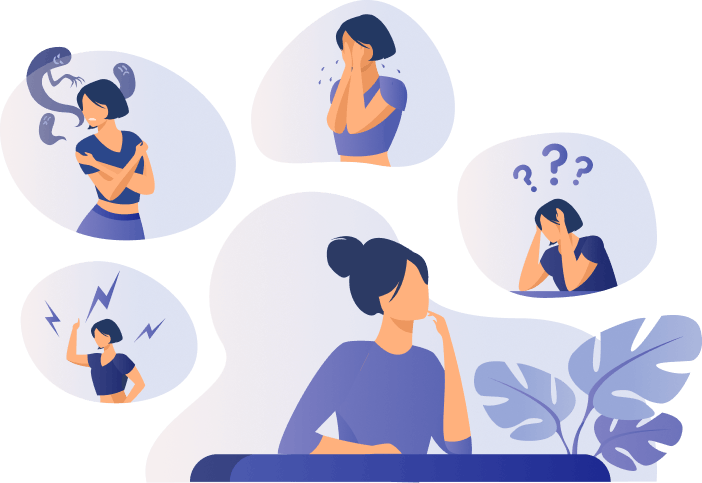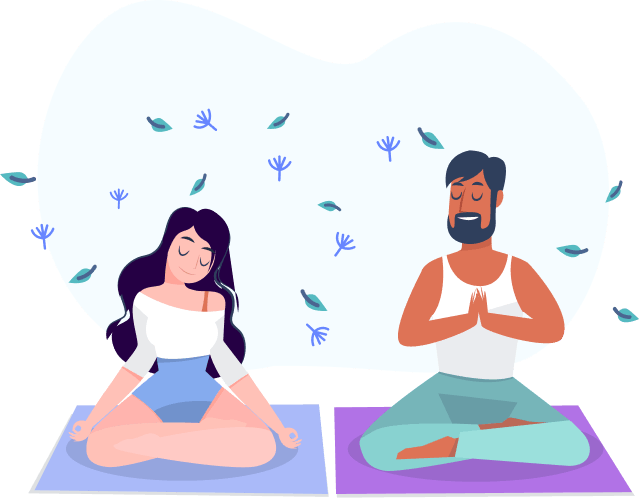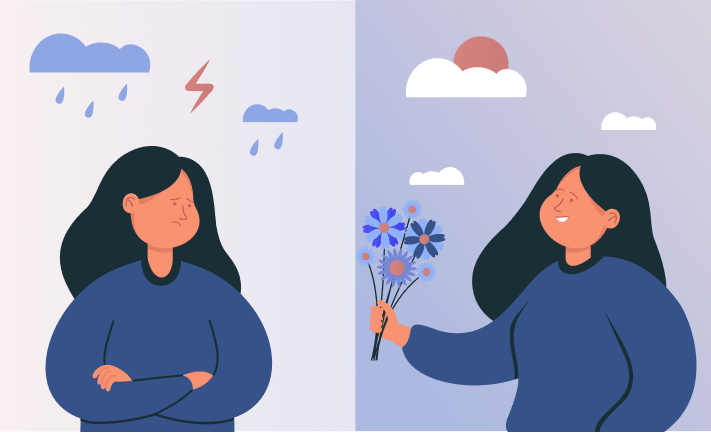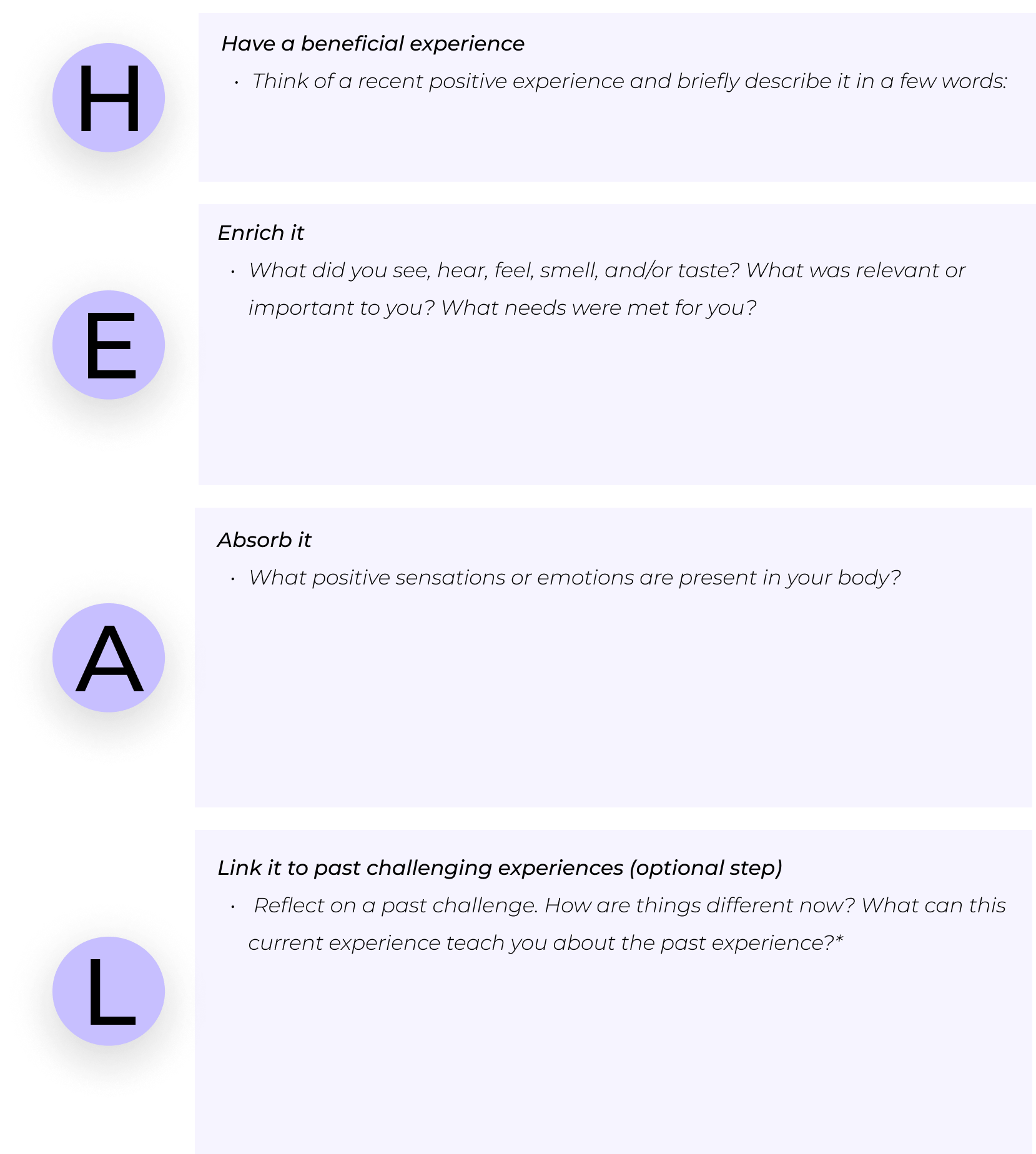Mindfulness for Positive Experiences

You can personalize the Mindfulness for Positive Experiences resource by downloading it HERE, and adding your own responses, or continue to view it below.
“Mindfulness is the awareness that arises from paying attention, on purpose, in the present moment and non-judgmentally."
-Jon Kabat-Zinn
We may often hear that mindfulness is a practice that can help us feel calmer when we’re facing challenging emotions, and though this is often true, mindfulness can also be used to recognize and savor the good in our lives. When we practice paying attention, on purpose, to things that are going well in our lives, we can take in the benefits of the positive experiences, begin to notice other things that are going well, and challenge our brain’s “negativity bias". We will explore this topic with the help of an exercise developed by clinical psychologist Rick Hanson, and follows the acronym H.E.A.L.
What’s the Negativity Bias?
The negativity bias is our brain’s natural tendency to look for what’s going wrong around us, in order to keep us alive. For early humans, this meant that the person who spotted the tiger hiding in the bush was more likely to survive than the person smelling the flowers.

Nowadays, we still have the same wiring in our brain, and as Rick Hanson says in his book Neurodharma, “we have a brain that’s like Velcro for painful, harmful experiences and Teflon for enjoyable useful ones” (Hanson, 2020).
Examples of the Negativity Bias
The negativity bias can show up in a lot of different ways, and a few examples might include:
- Getting plenty of positive feedback during a work evaluation, but only focusing on the one piece of criticism
- Experiencing a lot of positive interactions with a partner, but thinking the relationship will end because of a recent conflict
- Consistently attending to our child’s needs, but believing that we are a bad parent because of a simple mistake
- Doing well in most of our classes, but thinking about dropping out because we failed one test
Shifting the Negativity Bias
In danger, seeing the negative can help us survive, but too much focus on the negative can prevent us from enjoying the positive experiences that bring us joy, connection, peace, and fulfillment. By “taking in the good”, we can use another one of our brain’s natural abilities: neuroplasticity–the ability to change based on experience.

Benefits of “taking in the good”:
- Builds internal strength and resilience
- Reduces rumination about things of the past
- Lessens anxiety about potential pain in the future
- Helps us to feel more balanced in our thinking
- Prepares us to more readily notice what is going well, in future experiences
HEAL Exercise for “Taking in the Good”
H - Have a beneficial experience

- This can be any experience that feels good or meets our needs (e.g. safety, satisfaction, connection, etc.)
- We can do this by reflecting on a beneficial experience, past or present
E - Enrich it

- We can do this by pulling in the senses, and think about what we saw, heard, felt, smelled, and tasted
- We can also enrich it by thinking about what was relevant or important to us, and what needs were met
A - Absorb it

L - Link it to past challenging experiences (optional step)

- Linking is an optional step, and can also be beneficial in “filling in the gaps”, where we haven't been able to experience the current positive emotions or needs being met
- We can do this by reminding ourselves of a challenging experience in the past, and at the same time, recognize that we can still feel the positive experience in the present
- If we get caught up in thinking about the negative experience, we can choose to drop focus on it, and return to the positive one
Tips for Practice
- The exercise can be used “on the fly”, and can take less than a minute to complete
- Practicing with some consistency, over time will lead to the most benefits
- Remember that the exercise won’t necessarily create big, immediate results
- The exercise is not meant to ignore or invalidate other challenges that need our more immediate attention
“Think not lightly of good, saying, "It will not come to me." Drop by drop is the water pot filled. Likewise, the wise man, gathering it little by little, fills himself with good.”
-The Buddha
Practicing the HEAL Exercise
Now it’s your turn! Use the outline below to practice the HEAL exercise, or use the editable PDF found HERE.

*if the experience becomes too overwhelming, return focus to the more recent beneficial experience
Additional Resources
- Emotion Wheel
- Everyday Mindfulness
- Mindfulness Basics
- Mountain Meditation
- TED Talk: Hardwiring happiness: Dr. Rick Hanson at TEDxMarin 2013
Sources
- Hanson, R. (2020). Neurodharma: new science, ancient wisdom, and seven practices of the highest happiness. Harmony Books.
- Hanson, R. (2013). Hardwiring happiness: Dr. Rick Hanson at TEDxMarin 2013 [Video]. TED Conferences.
Call 911 if you’re having a
mental health emergency
Text Home to 741-741 if you're in emotional
distress and need immediate support
Call or text 988 Suicide &
Crisis Lifeline. Chat service
is available at 988lifeline.org.